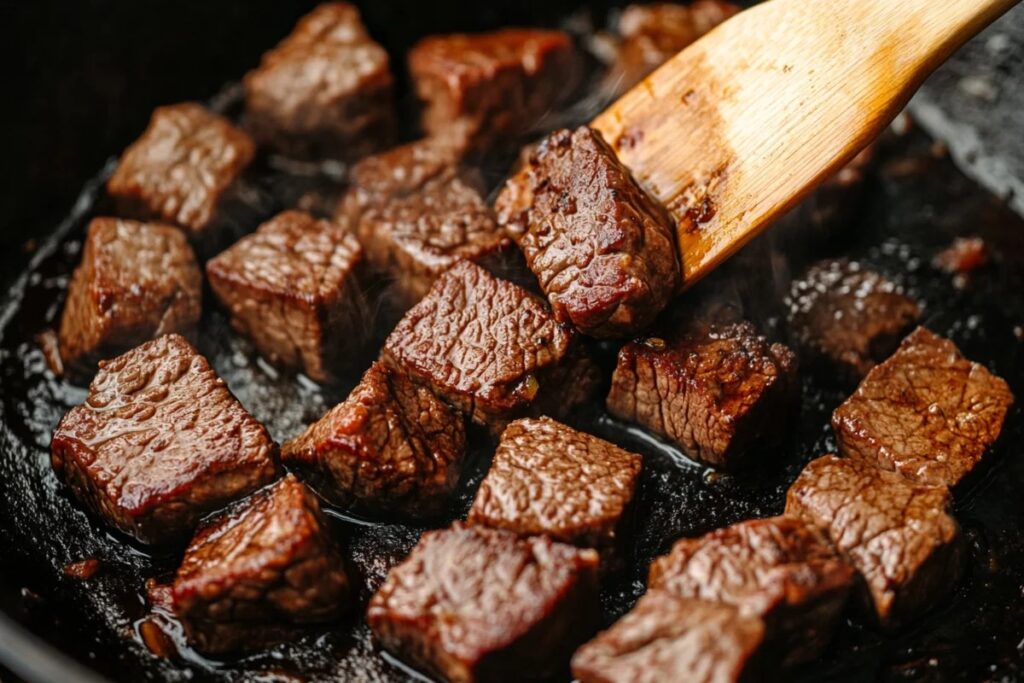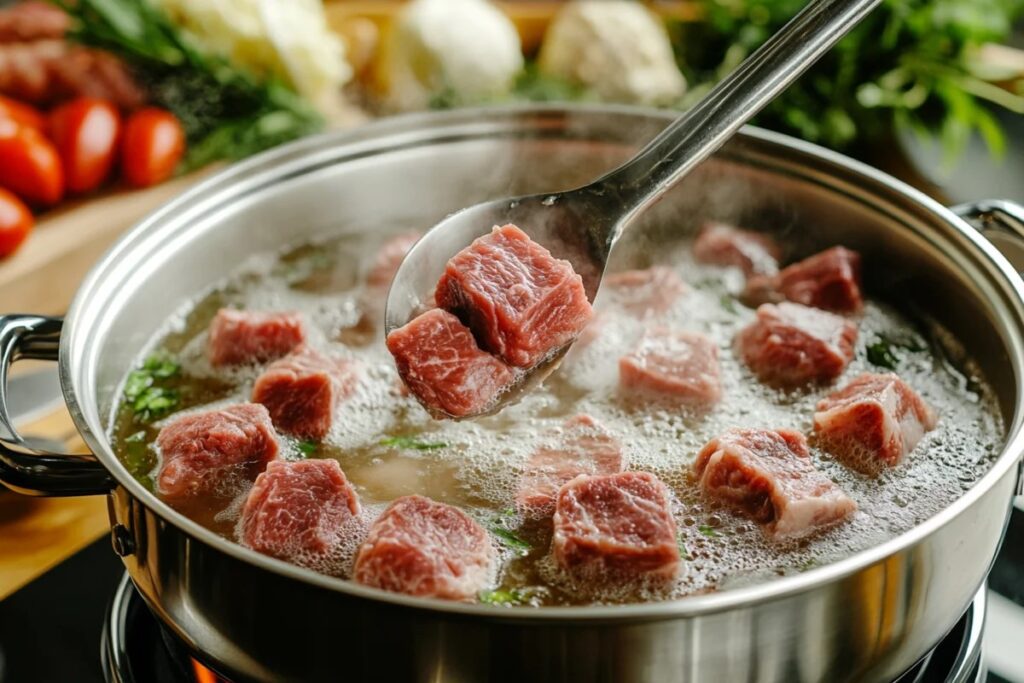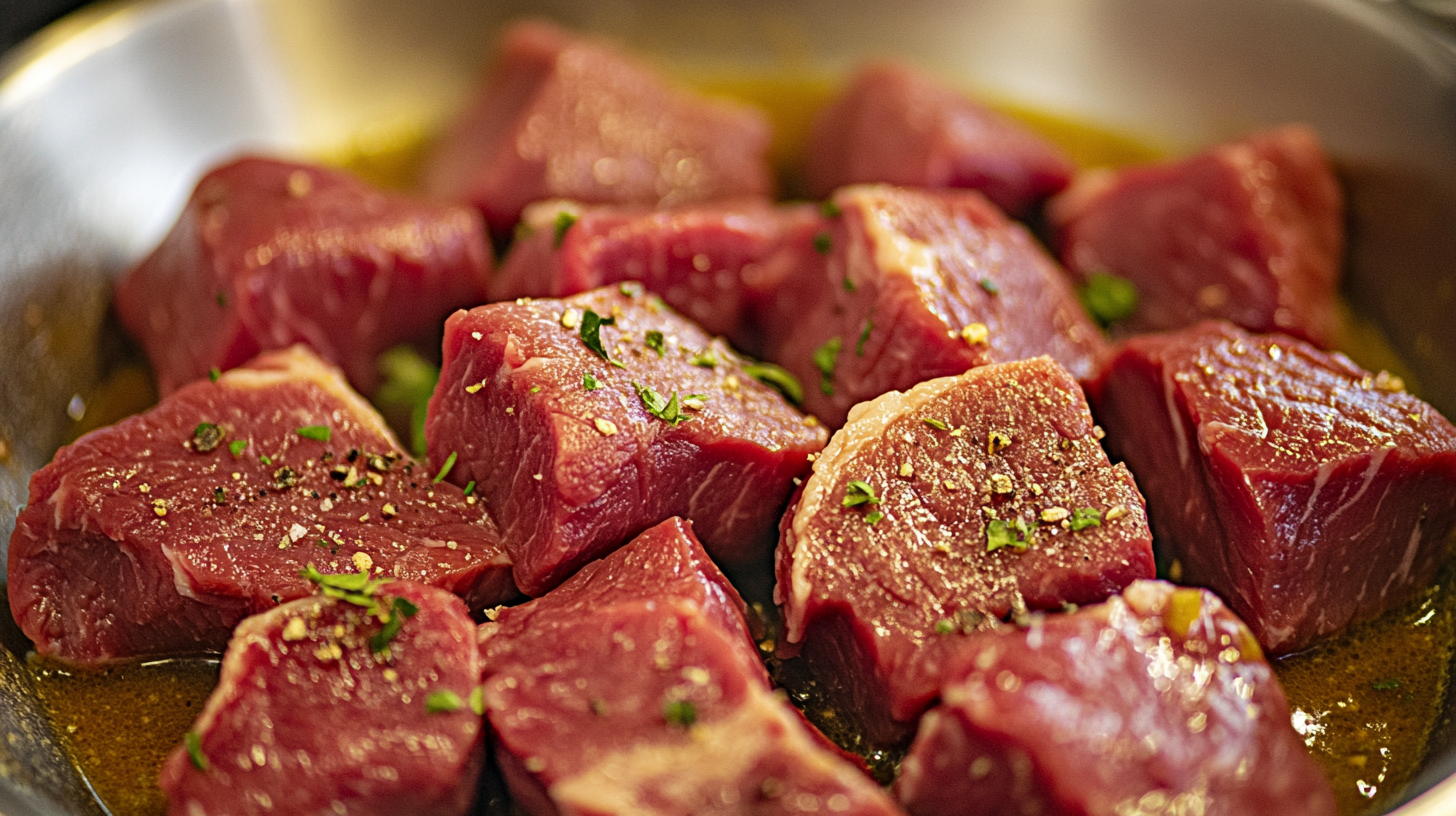Explore whether cooking beef beforehand enhances your soup’s flavor and texture with expert insights.
Introduction
Do you cook beef before adding to soup? This essential question can determine the depth and richness of your homemade soup. Understanding the best practices ensures a flavorful and satisfying meal every time.
The Importance of Preparing Beef for Soup
Do you cook beef before adding to soup? Absolutely, preparation is key. Properly cooking
Do you cook beef before adding to soup? Absolutely, preparation is key. Properly cooking beef enhances its flavor and ensures tenderness. Additionally, it helps in building a robust broth that forms the foundation of a great soup.
Benefits of Cooking Beef First
Cooking beef before adding it to soup offers several advantages:
- Enhanced Flavor: Browning beef caramelizes its surface, adding a rich, savory taste.
- Improved Texture: Pre-cooking ensures beef remains tender and doesn’t become chewy.
- Clearer Broth: Searing beef helps in removing impurities, resulting in a clearer soup.
Methods to Pre-Cook Beef for Soup
There are various methods to cook beef before incorporating it into your soup:
- Searing: Quickly browning the beef on all sides in a hot pan.
- Boiling: Briefly boiling to remove excess fat and impurities.
- Braising: Slowly cooking beef in liquid to tenderize it before adding to soup.
Techniques to Cook Beef Before Adding to Soup
Do you cook beef before adding to soup? Let’s delve into effective techniques to prepare beef for the best soup results.
Searing Beef for Maximum Flavor

Searing beef is a popular method to lock in flavors:
- Heat the Pan: Use a heavy-bottomed skillet over medium-high heat.
- Add Oil: A tablespoon of vegetable or olive oil prevents sticking.
- Brown the Beef: Cook the beef in batches to avoid overcrowding, ensuring a nice brown crust.
This process not only adds flavor but also improves the overall taste of your soup.
Boiling Beef to Remove Impurities
Boiling beef before adding it to soup helps in:
- Removing Blood: Reduces the soup’s cloudiness.
- Eliminating Excess Fat: Makes the broth healthier and less greasy.
To boil:
- Place Beef in Pot: Cover with cold water.
- Bring to a Boil: Skim off any foam that rises to the surface.
- Drain and Rinse: After boiling, drain the beef and rinse it before adding to soup.
Braising for Tender Meat
Braising is ideal for tougher cuts:
- Brown the Beef: As with searing.
- Add Liquid: Use broth or wine to cook the beef.
- Slow Cook: Simmer gently until the beef is tender.
This method ensures the beef remains soft and flavorful in your soup.
Choosing the Right Beef Cut for Soup
Do you cook beef before adding to soup? Selecting the appropriate cut is crucial for the best texture and flavor.
Best Cuts for Soup
Certain beef cuts are better suited for soup:
- Chuck Roast: Well-marbled and flavorful, perfect for slow cooking.
- Beef Shank: Contains marrow bones that enrich the broth.
- Brisket: Adds a deep, rich flavor when braised.
Lean vs. Fatty Cuts
While fatty cuts add richness, lean cuts can make the soup healthier. Balance is key:
- Fatty Cuts: Provide more flavor but can make the soup greasy.
- Lean Cuts: Healthier option but may require longer cooking to tenderize.
Choose based on your preference and the desired outcome of your soup.
Integrating Pre-Cooked Beef into Your Soup

Do you cook beef before adding to soup? Once the beef is prepped, integrating it correctly ensures a harmonious blend of flavors.
Timing Your Additions
Adding beef at the right time affects the soup’s texture:
- Early Addition: Allows flavors to meld but risks overcooking.
- Late Addition: Preserves tenderness but may result in less flavor infusion.
Balancing Ingredients
Ensure a balance of beef with vegetables and broth:
- Proportionate Meat: Avoid overpowering the soup with too much beef.
- Complementary Vegetables: Carrots, celery, and onions enhance the beef flavor.
- Rich Broth: A good broth ties all elements together seamlessly.
Simmering for Perfection
After adding pre-cooked beef:
- Low and Slow: Gentle simmering prevents toughening the meat.
- Stir Occasionally: Ensures even cooking and flavor distribution.
- Adjust Seasonings: Taste and tweak as needed for the perfect balance.
Enhancing Soup Flavor with Seasoned Beef
Do you cook beef before adding to soup? Seasoning beef prior to cooking amplifies the soup’s overall taste.
Marinating Beef Before Cooking
Marinating introduces additional flavors:
- Ingredients: Use herbs, spices, garlic, and a bit of acid like vinegar or lemon juice.
- Duration: Marinate for at least 30 minutes or overnight for deeper flavor penetration.
Using Spices and Herbs
Incorporate spices and herbs during the cooking process:
- Bay Leaves: Add a subtle earthy flavor.
- Thyme and Rosemary: Enhance the savory notes of the beef.
- Black Pepper: Provides a mild heat and depth.
Incorporating Aromatics
Aromatics like onions, garlic, and celery complement the beef:
- Sauté Before Adding Beef: Releases their flavors, enriching the soup.
- Layering Flavors: Adds complexity and depth to the broth.
Benefits of Pre-Cooking Beef for Soup
Do you cook beef before adding to soup? Pre-cooking offers multiple benefits that elevate your soup.
Improved Flavor Development
Cooking beef first allows for:
- Maillard Reaction: Creates complex flavors through browning.
- Enhanced Broth: Beef juices contribute to a richer broth.
Better Texture Control
Ensures the beef remains tender and succulent:
- Prevent Overcooking: Pre-cooked beef requires less time in the soup.
- Consistent Texture: Evenly cooked beef blends seamlessly with other ingredients.
Healthier Soup Options
Removing excess fat and impurities leads to a healthier soup:
- Lower Fat Content: Skimming off fat reduces greasiness.
- Cleaner Broth: Boiling beef removes unwanted impurities, making the soup lighter.
Common Mistakes When Cooking Beef for Soup
Do you cook beef before adding to soup? Avoiding common errors ensures a delicious outcome.
Overcrowding the Pan
Browning beef in batches prevents steaming and ensures proper searing. Overcrowding can lead to uneven cooking and loss of flavor.
Not Browning the Beef
Skipping the browning step results in a less flavorful soup. The Maillard reaction is essential for developing rich, savory notes.
Inadequate Seasoning
Underseasoning can make the soup bland. Always taste and adjust seasonings throughout the cooking process.
Using the Wrong Pot
Using a heavy-bottomed pot like a Dutch oven promotes even cooking and heat distribution, essential for simmering soup properly.
Tips for Perfectly Cooked Beef in Soup
Do you cook beef before adding to soup? Follow these tips for optimal results.
Use a Heavy-Bottomed Pot
A heavy pot ensures even heat distribution, preventing hotspots and ensuring the beef cooks uniformly.
Maintain a Gentle Simmer
A gentle simmer allows flavors to meld without toughening the meat. Avoid boiling, which can make beef chewy.
Let It Rest
Allowing the soup to rest after cooking lets the flavors develop further and the beef to tenderize even more.
Slice Against the Grain
Cutting beef against the grain shortens the muscle fibers, resulting in a more tender bite.
Variations in Cooking Beef for Different Soups
Do you cook beef before adding to soup? Different soups may require variations in how beef is prepared.
Beef Stew
For beef stew, sear the beef and cook it slowly with hearty vegetables, allowing the flavors to deepen over time.
Pho or Broth-Based Soups
In lighter soups like pho, quickly blanching beef before adding ensures tenderness without overpowering the broth.
Chili
Pre-cooked beef in chili enhances the dish’s robustness, allowing the spices and beans to meld with the meat’s flavor.
Asian Soups
In Asian-inspired soups, marinating beef with soy sauce and ginger before cooking can infuse the meat with authentic flavors.
Incorporating Beef into Different Types of Soup
Do you cook beef before adding to soup? How you incorporate beef can vary based on the soup type.
Chunky Soups
In chunky soups, add pre-cooked beef in larger pieces for a hearty texture that complements chunky vegetables.
Pureed Soups
For pureed soups, blending some of the beef with vegetables can create a creamy consistency while retaining pieces of meat.
Clear Soups
In clear soups, use thinly sliced or shredded pre-cooked beef to maintain the soup’s clarity and lightness.
Cream-Based Soups
Adding pre-cooked beef to cream-based soups ensures the meat integrates smoothly without curdling the dairy.
Adjusting Cooking Times for Pre-Cooked Beef
Do you cook beef before adding to soup? Adjusting cooking times ensures the beef remains tender.
Shorter Simmering Periods
Since beef is already cooked, reduce the simmering time to prevent overcooking and drying out the meat.
Infusing Flavors Quickly
With pre-cooked beef, you can infuse flavors faster by adding concentrated broths or seasonings towards the end of cooking.
Balancing Ingredients
Ensure that other ingredients like vegetables and grains are cooked appropriately without oversteaming the beef.
Enhancing Soup with Pre-Cooked Beef
Do you cook beef before adding to soup? Enhance your soup further by utilizing the pre-cooked beef effectively.
Creating a Rich Base
Use the drippings from seared beef to build a flavorful base, adding depth to the soup’s overall taste.
Incorporating Beef Broth
Combine pre-cooked beef with a rich beef broth to elevate the soup’s savory profile.
Layering Flavors
Add additional layers of flavor by incorporating ingredients like Worcestershire sauce, tomato paste, or balsamic vinegar after adding the beef.
Storing and Reheating Soup with Pre-Cooked Beef
Do you cook beef before adding to soup? Proper storage and reheating preserve the soup’s quality.
Refrigeration Tips
Store the soup in airtight containers in the refrigerator for up to five days. Ensure it cools before refrigerating to maintain freshness.
Freezing for Later
Freeze the soup in portioned containers for up to three months. Thaw overnight in the refrigerator before reheating.
Reheating Without Overcooking
Gently reheat the soup on the stovetop over low heat, stirring occasionally to prevent the beef from drying out.
Frequently Asked Questions (FAQs)
Do you cook beef before putting in soup?
Yes, cooking beef before adding it to soup enhances flavor and ensures tenderness. Searing or boiling beef helps develop a richer broth and better texture.
Do you have to cook meat before putting in soup maker?
Not necessarily, but pre-cooking meat can improve the soup’s flavor and texture. While a soup maker can cook meat within the appliance, searing beforehand adds depth.
Can you add raw meat to soup?
Yes, you can add raw meat to soup, but it requires longer cooking times to ensure the meat is fully cooked and tender. Pre-cooking is recommended for better flavor and texture.
How long does it take for beef to get tender in soup?
Typically, beef becomes tender after simmering for 1.5 to 2 hours, depending on the cut and cooking method. Slow cooking ensures the meat absorbs flavors and softens properly.
Conclusion
Do you cook beef before adding to soup? Absolutely, pre-cooking beef is a crucial step that enhances the soup’s flavor, texture, and overall quality. By searing, boiling, or braising the beef beforehand, you ensure a richer broth and tender meat that elevate your homemade soup to new heights. Additionally, understanding the right cuts and cooking techniques allows for a more satisfying and delicious meal. Therefore, incorporating these practices will consistently result in flavorful and hearty soups that are sure to impress.
